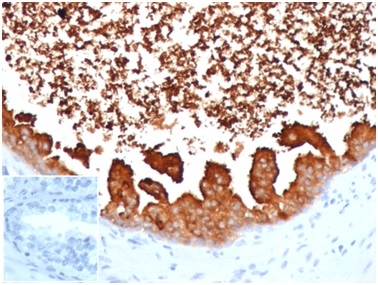Learn about our comprehensive antibody validation methods to ensure monospecificity. Antibody Validation>>

Formalin-fixed, paraffin-embedded human prostate carcinoma stained with Lactotransferrin Mouse Monoclonal Antibody (LTF/4075). Inset: PBS instead of primary, secondary negative control.
Ferritin and transferrins manage necessary iron-binding functions for iron metabolism. Transferrins comprise a class of single-chain, two-sited, metal-binding proteins expressed throughout the fluid and cells of vertebrates. The three major types of transferrin include serotransferrin, lactotransferrin (lactoferrin) and ovotransferrin. Lactoferrin is found in milk, tears and leukocytes. It degrades an IgA1protease secreted by Haemophilus influenzae and, consequently, allows the human IgA1antibody to effectively abolish Haemophilus influenzae colonization. Lactoferrin also attenuates the pathogenic potential of Haemophilus influenzae by proteolytic degradation of the Hap adhesin. While lactoferrin may aid in the transmission of human T cell leukemiavirus type 1, it inhibits HIV-1 replication at the level of viral fusion and entry into cells. The inhibitory effects of lactoferrin on mixed lymphocyte reactions suggest that it may have the ability to sense the activation status of lymphocytes.
There are no reviews yet.